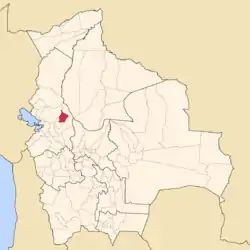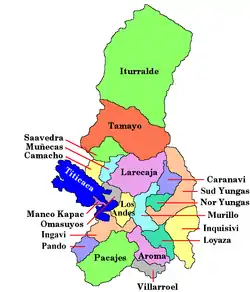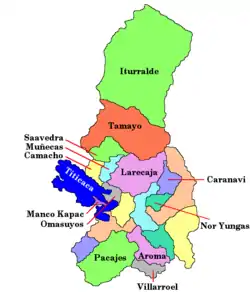Caranavi Province
Caranavi Province is one of the twenty provinces of the Bolivian La Paz Department and is situated in the department's eastern parts. The province was created by Law 1401 on 16 December 1992 from a portion of what was then Nor Yungas Province.[1] The creation of the province had been a local cause embraced by Ramiro Revuelta, a Deputy in the national legislature who was assassinated on November 28, 1992.[2]
Caranavi | |
|---|---|
Province | |
 Location of Caranavi Province within Bolivia | |
 Provinces of the La Paz Department | |
| Coordinates: 15°40′0″S 67°25′0″W | |
| Country | |
| Department | La Paz Department |
| Municipalities | 2 |
| Established | 1992 |
| Capital | Caranavi |
| Area | |
| • Total | 3,400 km2 (1,300 sq mi) |
| Population (2012 census) | |
| • Total | 59,365 |
| • Density | 17/km2 (45/sq mi) |
Location
Caranavi Province is located between 15° 20' and 16° 03' South and between 67° 07' and 67° 42' West. It extends over 55 km from West to East, and 75 km from North to South.
The province is situated on the Bolivian Altiplano east of Lake Titicaca, on the headwaters of Río Beni, and borders Larecaja Province and in the Northwest, Pedro Domingo Murillo Province in the Southwest, Nor Yungas Province in the South, and Sud Yungas Province in the East and Northeast.
Population
The population of Caranavi Province has increased by circa 40% over the recent two decades:
- 1992: 43,093 inhabitants (census)[3]
- 2001: 51,153 inhabitants (census)
- 2005: 56,167 inhabitants (est.)[4]
- 2010: 59,090 inhabitants (est.)[5]
40.6% of the population are younger than 15 years old. (1992)
The literacy rate of the population is 83.1%. (1992)
92.7% of the population speak Spanish, 71.6% speak Aymara, and 11.1% Quechua. (1992)
88.7% of the population have no access to electricity, 65.6% have no sanitary facilities. (1992)
68.0% of the population are Catholics, 22.9% are Protestants. (1992)
Economy
As of 2003, Caranavi is the main source for Bolivian coffee production and supplies organic coffee to the national and world market.[6]
Division
Since 23 December 2009, the province is divided into two municipalities[7][8][9][10] which are further subdivided into 21 cantons.
| Section | Municipality | Seat |
|---|---|---|
| 1st | Caranavi Municipality | Caranavi |
| 2nd | Alto Beni Municipality | Caserío Nueve |
At the time of its creation in 1992, the province consisted of fourteen cantons: Caranavi, Choro, Taypilaya, Santa Fe, Alcoche, Villa Elevacion, Inca Huara De Ckullu Kuchu, Carrasco Uyunense, Inicua, Santa Ana de Alto Beni, San Pablo, Chojña, Santa Rosa, Belen and Eduardo Abaroa.[1]
References
- "Ley Nº 1401 de 16 de diciembre de 1992". Lexivox.
- "Caranavi de tercera sección a provincia". El Diario. 2014-12-16. Retrieved 2018-01-20.
- Santa Cruz Website Archived 2008-12-02 at the Wayback Machine
- Instituto Nacional de Estadística Archived August 25, 2007, at the Wayback Machine
- Instituto Nacional de Estadística - Proyecciones Archived 2008-11-18 at the Wayback Machine
- "Approximately 85 per cent of Bolivia's coffee production comes from the Caranavi area. FECAFEB, like COCLA in Peru, recognizes the benefits of organic coffee and has been promoting organic coffee production since the early 1990s."Hellin, Jon; Sophie Higman (April 2003). Feeding the market: South American farmers, trade and globalization. Kumarian Press. ISBN 978-1-56549-172-4.
- www.bolivia.com (Spanish)
- www.planguarani.com Archived 2011-07-15 at the Wayback Machine (Spanish)
- www.enlared.org.bo Archived January 7, 2010, at the Wayback Machine (Spanish)
- Alto Beni municipality was created by Law 4131 on 23 December 2009. "Alto Beni nace como municipio de Caranavi". Cambio. January 5, 2010. Archived from the original on 6 July 2011. Retrieved 17 September 2010.
External links
- General map of province
- Detailed map of province towns and rivers
- Population data (Spanish)
- Social data (Spanish)
